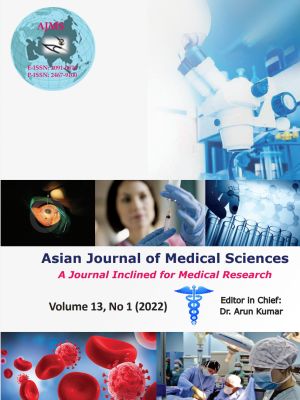A study on the demographic, clinical, and radiological profile of lineage B.1.1.7 (United Kingdom) strain Covid-19 patients at Telangana institute of medical sciences and research, Hyderabad
Keywords:
Coronavirus disease 2019, Genomic sequencing, Mutation, Reverse transcription polymerase chain reaction, Severe acute respiratory syndrome coronavirus 2 B.1.1.7, SymptomAbstract
Background: Emergence of variants with specific mutations in key epitopes in the spike protein of severe acute respiratory syndrome coronavirus 2 (SARS-CoV-2) raises concerns pertinent to its severity.
Aims and Objectives: To assess the demographics, clinico-radiological pattern, and outcome of reverse transcription-polymerase chain reaction (RT-PCR) positive isolated coronavirus disease 2019 (COVID-19) patients arrived from the United Kingdom (UK).
Materials and Methods: A cross-sectional, observational study was conducted in RT-PCR positive COVID-19 patients arrived from the UK, from December 2020 to February 2021. Nasopharyngeal samples of all patients were sent for whole-genome sequencing of SARS-CoV-2. The aimed parameters were compared between the B.1.17 positive and non-B.1.1.7 groups, among the people, arrived from the UK. All statistical tests with P<0.05 were considered significant.
Results: A total of 59 SARS-CoV2 infected patients, who arrived from the UK, were isolated from December 2020 to February 2021 at Telangana Institute of Medical Sciences hospital, Hyderabad, were enrolled in the study. Of these, 27 patients (mean age-31.81±11.28 years) were infected with the B.1.1.7, diagnosed by whole genomic sequencing. Males were predominant in our study. Personal habits such as smoking, alcohol intake were higher among the sequenced group with a significant P<0.05. The most common symptoms observed in the sequenced group were cough (22.22%), sore throat (22.22%), cold (11.11%), fever (11.11%), and in the unsequenced group were cough (22.22%), cold (6.25%), fever (6.25%). In the sequenced group, chest X-ray posteroanterior view was normal in 74%, patchy ground-glass opacities was observed in 25.92% patients, whereas in the unsequenced group it was 84.37% and 15.62%, respectively. Asymptomatic patients, observed in the sequenced and unsequenced group were 48.18% and 78.12%, respectively, and symptomatic patients were 51.85% and 21.87%, respectively. We found a statistically significant difference between sequenced and unsequenced patients in the asymptomatic group with a significant P<0.05. In the sequenced and unsequenced group, mild cases were 48.18% and 18.75%, moderate cases were 3.7% and 3.12%, respectively. We found no evidence of an association between disease severity and lineage B.1.17.
Conclusion: Our data, within the context and limitations of a real-world study, provide initial reassurance that severity in hospitalized patients with B.1.1.7 is not markedly different from severity in those without B.1.1.7.
Downloads
Downloads
Published
How to Cite
Issue
Section
License
Copyright (c) 2021 Asian Journal of Medical Sciences

This work is licensed under a Creative Commons Attribution-NonCommercial 4.0 International License.
Authors who publish with this journal agree to the following terms:
- The journal holds copyright and publishes the work under a Creative Commons CC-BY-NC license that permits use, distribution and reprduction in any medium, provided the original work is properly cited and is not used for commercial purposes. The journal should be recognised as the original publisher of this work.
- Authors are able to enter into separate, additional contractual arrangements for the non-exclusive distribution of the journal's published version of the work (e.g., post it to an institutional repository or publish it in a book), with an acknowledgement of its initial publication in this journal.
- Authors are permitted and encouraged to post their work online (e.g., in institutional repositories or on their website) prior to and during the submission process, as it can lead to productive exchanges, as well as earlier and greater citation of published work (See The Effect of Open Access).




